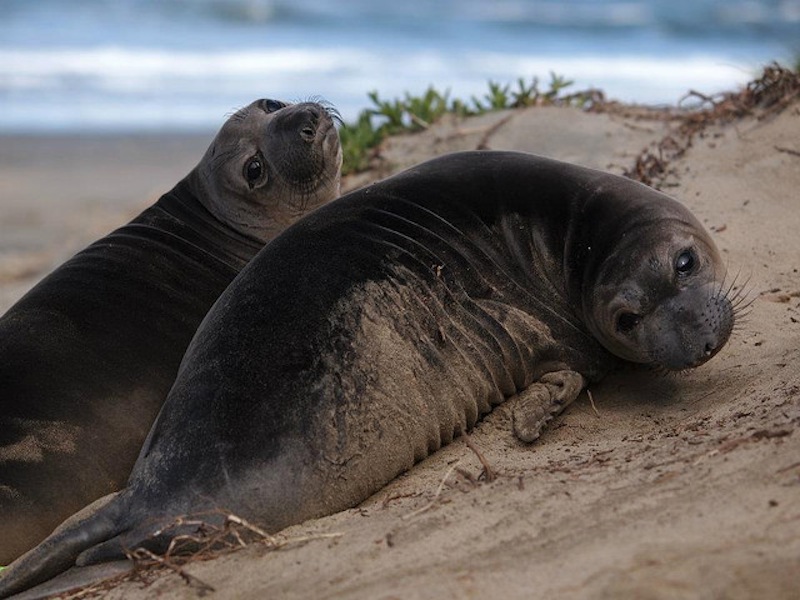Elephant Seals Survive Deep Dives with 'Smokers' Blood'

Elephant seals have surprisingly high levels of naturally produced carbon monoxide — a noxious gas that is deadly at high concentrations — in their blood, a new study finds. In fact, the amount of carbon monoxide found in the blood of these large mammals is roughly the same as that in people who smoke 40 or more cigarettes each day, researchers say.
Carbon monoxide is an odorless and colorless gas that is naturally produced in small quantities in humans and animals. The scientists are unsure why elephant seals have such unexpectedly high levels of the gas in their blood, but the researchers suggest it could protect the animals from injury when they dive to extreme depths in search of food.
In humans and animals, carbon monoxide is a byproduct of the breakdown of hemoglobin, which carries oxygen in red blood cells throughout the body, said study leader Michael Tift, a comparative physiologist at the Scripps Institution of Oceanography at the University of California, San Diego. [Gallery: California's Deep-Diving Elephant Seals]
Carbon monoxide binds to hemoglobin, effectively suffocating the protein and preventing it from transporting oxygen. In healthy adult humans, about 1 percent of hemoglobin is bound to carbon monoxide. But the amount of hemoglobin incapacitated by carbon monoxide can reach as high as 10 percent in elephant seals and chronic, heavy cigarette smokers (who are exposed to carbon monoxide from burning and inhaling tobacco), the researchers said.
"Elephant seals are known to have the highest blood volume of any mammal, so we knew there was the potential for producing a lot of carbon monoxide," Tift told Live Science. "When we looked into the levels of carbon monoxide in the blood, we suspected there could be a lot."
Yet, while elephant seals appear to have elevated levels of carbon monoxide in their bloodstreams, the concentration of the gas is not so high as to cause harm, the researchers said.
"The levels in elephant seals are not high enough to inhibit oxygen transport or lead to carbon monoxide poisoning," Tift said.
Sign up for the Live Science daily newsletter now
Get the world’s most fascinating discoveries delivered straight to your inbox.
Carbon monoxide's colorless and odorless properties have earned it a reputation as a "silent killer." When the gas invades up to 20 percent of hemoglobin stores, humans typically begin to suffer the effects of carbon monoxide poisoning — lightheadedness, headaches and other flu-like symptoms. The gas typically becomes deadly when it incapacitates more than 50 percent of hemoglobin stores, Tift said.
The researcher and his colleagues sampled 24 elephant seals, ranging in age from pups to juveniles to adults, at the Año Nuevo State Reserve near Santa Cruz, California.
The researchers are not sure why elephant seals naturally produce higher levels of carbon monoxide, but suspect it may have something to do with the animal's prolific diving abilities. The mammals can dive more than 5,000 feet (1,500 meters) beneath the surface of the sea, holding their breath and conserving oxygen for impressively long periods of time.
"Elephant seals will shut off blood to specific organs and tissues as they are diving," Tift said. "Recently, we found that low levels of carbon monoxide can be therapeutic in treating certain conditions where blood has been shut off to muscles."
As such, carbon monoxide could protect elephant seals from reperfusion injuries, which occur when blood returns to tissue after sustained periods of oxygen deprivation.
"We can't say for sure that the carbon monoxide is therapeutic for elephant seals, but it definitely has the potential," Tift said. "If they didn't have this high level of carbon monoxide, there's a chance we would see injuries from reperfusion."
The researchers are testing this hypothesis by studying other diving and non-diving animals, including sea lions, penguins and terrestrial birds.
"We want to know, is high carbon monoxide found in all marine mammals? Is it found in deep divers, or both divers and non-divers?" Tift said.
The results of the new study were published online today (May 14) in the Journal of Experimental Biology.
Follow Denise Chow on Twitter @denisechow. Follow Live Science @livescience, Facebook & Google+. Original article on Live Science.

Denise Chow was the assistant managing editor at Live Science before moving to NBC News as a science reporter, where she focuses on general science and climate change. Before joining the Live Science team in 2013, she spent two years as a staff writer for Space.com, writing about rocket launches and covering NASA's final three space shuttle missions. A Canadian transplant, Denise has a bachelor's degree from the University of Toronto, and a master's degree in journalism from New York University.









